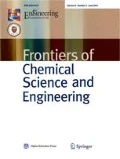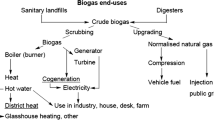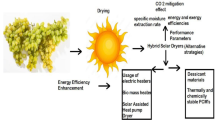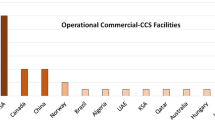Abstract
Nowadays a lot of low-grade heat is wasted from the industry through the off- and flue-gasses with different compositions. These gases provide the sensitive heat with utilisation potential and latent heat with the components for condensation. In this paper, process integration methodology has been applied to the partly condensed streams. A hot composite curve that represents the gas mixture cooling according to equation of state for real gases was drawn to account the gas-liquid equilibrium. According to the pinch analysis methodology, the pinch point was specified and optimal minimal temperature difference was determined. The location of the point where gas and liquid phases can be split for better recuperation of heat energy within heat exchangers is estimated using the developed methodology. The industrial case study of tobacco drying process off-gasses is analysed for heat recovery. The mathematical model was developed by using MathCad software to minimise the total annualised cost using compact plate heat exchangers for waste heat utilisation. The obtained payback period for the required investments is less than six months. The presented method was validated by comparison with industrial test data.

Similar content being viewed by others
References
OECD/IEA. World Energy Outlook 2013. 2015, http://www. worldenergyoutlook.org/weO2013/
Klemeš J, Friedler F, Bulatov I, Varbanov P. Sustainability in the process industry. Integration and optimization. New York: The McGraw-Hill Co-s. Inc, 2010
Oluleye G, Jobson M, Smith R, Perry S J. Evaluating the potential of process sites for waste heat recovery. Applied Energy, 2016, 161: 627–646
Khaled M, Ramadan M, El Hage H. Parametric analysis of heat recovery from exhaust gases of generators. Energy Procedia, 2015, 75: 3295–3300
Kilkovsky B, Stehlik P, Jegla Z, Tovazhnyansky L L, Arsenyeva O, Kapustenko P O. Heat exchangers for energy recovery in waste and biomass to energy technologies–I. Energy recovery from flue gas. Applied Thermal Engineering, 2014, 64(1): 213–223
Szulc P, Tietze T, Wójs K. Numerical analysis of a waste heat recovery process with account of condensation of steam from flue gases. Archives of Civil and Mechanical Engineering, 2015, 15(4): 1017–1023
Maalouf S, Ksayer E B, Clodic D. Investigation of direct contact condensation for wet flue-gas waste heat recovery using Organic Rankine Cycle. Energy Conversion and Management, 2016, 107: 96–102
Zegenhagen M T, Ziegler F. Simple models for the heat exchange from exhaust gas to super- and sub-critical refrigerant R134a at high temperature differences. Applied Thermal Engineering, 2015, 89: 990–1000
Han X, Liu M, Wang J, Yan J, Liu J, Xiao F. Simulation study on lignite-fired power system integrated with flue gas drying and waste heat recovery–Performances under variable power loads coupled with off-design parameters. Energy, 2014, 76: 406–418
Xu C, Xu G, Yang Y, Zhao S, Zhang K, Zhang D. An improved configuration of low-temperature pre-drying using waste heat integrated in an air-cooled lignite fired power plant. Applied Thermal Engineering, 2015, 90: 312–321
Aziz M, Oda T, Kashiwagi T. Enhanced high energy efficient steam drying of algae. Applied Energy, 2013, 109: 163–170
Golman B, Julklang W. Simulation of exhaust gas heat recovery from a spray dryer. Applied Thermal Engineering, 2014, 73(1): 899–913
Julklang W, Golman B. Effect of process parameters on energy performance of spray drying with exhaust air heat recovery for production of high value particles. Applied Energy, 2015, 151: 285–295
Hamad A, Fayed M E. Simulation-aided optimization of volatile organic compounds recovery using condensation. Chemical Engineering Research & Design, 2004, 82(7): 895–906
Klemeš J J, ed. Handbook of Process Integration (PI): Minimisation of Energy and Water Use, Waste and Emissions. Cambridge: Woodhead/Elsevier, 2013, 127–350
Nemet A, Klemeš J J, Varbanov P S, Mantelli W. Heat integration retrofit analysis—an oil refinery case study by Retrofit Tracing Grid Diagram. Frontiers of Chemical Science and Engineering, 2015, 9(2): 163–182
Klemeš J J, Arsenyeva O, Kapustenko P, Tovazhnyanskyy L. Compact Heat Exchangers for Energy Transfer Intensification: Low Grade Heat and Fouling Mitigation. Florida: CRC Press, 2015, 283–314
Yong J Y, Varbanov P S, Klemeš J J. Heat exchanger network retrofit supported by extended grid diagram and heat path development. Applied Thermal Engineering, 2015, 89: 1033–1045
Redlich O, Kwong J N. On the thermodynamics of solutions. V. An equation of state. Fugacities of gaseous solutions. Chemical Reviews, 1949, 44(1): 233–244
Rowley R L, Wilding W V, Oscarson J L, Yang Y, Zundel N A, Daubert T E, Danner R P. DIPPR data compilation of pure chemical properties. Design Institute for Physical Properties. New York: AICHE, 2007
Perry’s Chemical Engineers’ Handbook. New York: McGraw-Hill, 2008, 4-1: 4–36
Smith R. Chemical Process: Design and Integration. West Sussex, UK: John Wiley & Sons, Ltd., 2005, 399–550
Alfa Laval. TS6 Plate Heat Exchanger. 2015, www.alfalaval.com/solution-finder/products/gasketed-industrial-range-phe/Documents/TS6_plate_heat_exchanger.pdf
Alfa Laval. M3 Plate Heat Exchanger. 2015, www.alfalaval.com/solution-finder/products/gasketed-industrial-range-phe/Documents/M3.pdf
Tovazhnyansky L L, Kapustenko P A. Heat and mass transfer in the condensation of steam from a steam and gas mixture in plate condenser channels. Teploenergetika, 1984, 2: 52–54 (in Russian)
Tovazhnyansky L L, Kapustenko P O, Nagorna O G, Perevertaylenko O Y. The simulation of multicomponent mixtures condensation in plate condensers. Heat Transfer Engineering, 2004, 25(5): 16–22
Arsenyeva O P, Tovazhnyansky L L, Kapustenko P O, Khavin G L. Optimal design of plate-and-frame heat exchangers for efficient heat recovery in process industries. Energy, 2011, 36(8): 4588–4598
Gariev A O, Klemeš J J, Kusakov S K, Tovazhnyanskyy L L, Anokhin P, Kapustenko P O, Arsenyeva O P, Cucek L. The development of heat substation for drying waste heat utilisation. Chemical Engineering Transactions, 2014, 39: 1405–1410
Gendebien S, Bertagnolio S, Lemort V. Investigation on a ventilation heat recovery exchanger: Modeling and experimental validation in dry and partially wet conditions. Energy and buildings, 2013, 62: 176–189
Author information
Authors and Affiliations
Corresponding author
Rights and permissions
About this article
Cite this article
Arsenyeva, O.P., Čuček, L., Tovazhnyanskyy, L.L. et al. Utilisation of waste heat from exhaust gases of drying process. Front. Chem. Sci. Eng. 10, 131–138 (2016). https://doi.org/10.1007/s11705-016-1560-8
Received:
Accepted:
Published:
Issue Date:
DOI: https://doi.org/10.1007/s11705-016-1560-8




